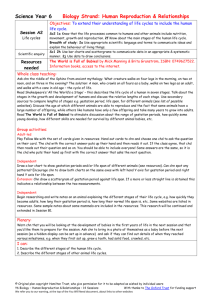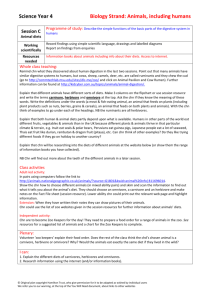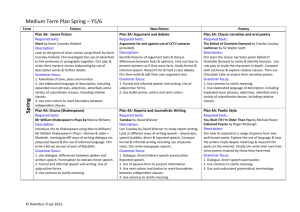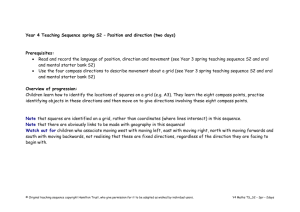Autumn TS 8 - Hamilton Trust
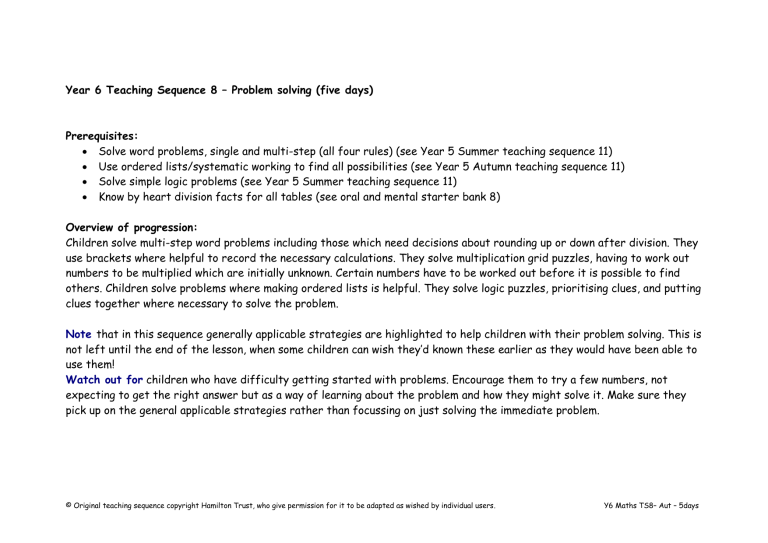
Year 6 Teaching Sequence 8 – Problem solving (five days)
Prerequisites:
Solve word problems, single and multi-step (all four rules) (see Year 5 Summer teaching sequence 11)
Use ordered lists/systematic working to find all possibilities (see Year 5 Autumn teaching sequence 11)
Solve simple logic problems (see Year 5 Summer teaching sequence 11)
Know by heart division facts for all tables (see oral and mental starter bank 8)
Overview of progression:
Children solve multi-step word problems including those which need decisions about rounding up or down after division. They use brackets where helpful to record the necessary calculations. They solve multiplication grid puzzles, having to work out numbers to be multiplied which are initially unknown. Certain numbers have to be worked out before it is possible to find others. Children solve problems where making ordered lists is helpful. They solve logic puzzles, prioritising clues, and putting clues together where necessary to solve the problem.
Note that in this sequence generally applicable strategies are highlighted to help children with their problem solving. This is not left until the end of the lesson, when some children can wish they’d known these earlier as they would have been able to use them!
Watch out for children who have difficulty getting started with problems. Encourage them to try a few numbers, not expecting to get the right answer but as a way of learning about the problem and how they might solve it. Make sure they pick up on the general applicable strategies rather than focussing on just solving the immediate problem.
© Original teaching sequence copyright Hamilton Trust, who give permission for it to be adapted as wished by individual users. Y6 Maths TS8– Aut – 5days
Objectives:
Use all four operations to solve single and multi-step word problems
Use brackets
Decide whether to round up or down after division
Solve mathematical puzzles
Use ordered lists/systematic working to find all possibilities
Solve logic problems
Whole class
Display the following problem:
207 chn and 15 adults going on a school trip to the theatre. The coaches hold 50 passengers.
How many coaches are needed?
Ask chn to discuss in pairs what needs to be done to the numbers in the problem to solve it.
Help chn to agree the calculation (this is the hard part!) and show how it can be written using brackets: (207 + 15) ÷ 50
Ask chn to work out 222 divided by 50 on their whiteboards. Agree there are four 50s in 222, and 22 left over. So how many coaches do we need? Five. Do we need to round the
answer up or down? Why?
Display the following problem:
Each child has paid £5.80 to go on this theatre trip. The adults are paid for by the school. The coaches cost £200 each, and the play is free. How much is left to buy snacks at the theatre?
Ask chn to discuss in pairs what needs to be
Group activities
Group of 4-5 children
Write the following contexts and measures on the flipchart: vets, school, holiday, shopping, cooking weight, length, money and capacity.
Ask chn to work in pairs to choose a context and a measure and to write a two-step word problem. Pairs of chn then solve each others’ word problems.
Harder: Write problems with more than two steps.
Paired/indiv practice
Ask chn to work on a series of word problems involving several steps (see resources). Encourage chn to sketch simple diagrams
(not detailed pictures!), number lines or other jottings to help them, or to try some initial numbers to help them to get started. Ask that they record all of these in their books. The difficult part is getting form reading the problem to writing some calculations!
Easier: Activity sheet with easier numbers to work with.
Harder: Activity sheet with slightly harder contexts, or more than two steps.
Resources
Activity sheets of word problems (see
resources)
© Original teaching sequence copyright Hamilton Trust, who give permission for it to be adapted as wished by individual users. Y6 Maths TS8– Aut – 5days
done to the numbers in the problem to solve it.
Agree the calculation and show how it can be written using brackets:
(£5.80 × 207) – (£200 × 5)
Looking at this calculation, do you think there will be any money left over? Why do you think that? How does rounding help?
Display the following multiplication grid:
X 3
21 49 63
8 56
81
Explain how multiplication grids work (the outside numbers are multiplied to give the numbers in the central part of the table). Our challenge is to complete the grid. Are there any spaces that you can see that we can fill
straight away? Fill in 24 (8 × 3). What do we
multiply 3 by to give 21? Fill in 7 on the lefthand side, and now ask chn to discuss in pairs what other number can be filled in. Take feedback. Agree that filling in 7 on the left was a bit of a break through, as now we can complete the top row, and then the rest of the table. Work together to complete the table, encouraging chn to explain their reasoning.
Group of 4-5 children
Show chn the following multiplication grid:
X
40
45
16
12
18
56
42
This time we have no red numbers, and
not even all the ‘inside’ numbers! Ask chn to discuss which numbers could go along the top row, and which numbers cant’ go there. Take feedback. Agree that only 5, 2 and 7 can go in the top row. How did you work this out? Ask chn to discuss which numbers can go in the cells in the left column, encouraging them to share their reasoning.
Complete the table to finish. Ask chn to work in pairs to make their own multiplication grid on whiteboards, and then to choose four numbers to rub out for the rest of the group to work out.
Ask chn to work in pairs on similar grids to the whole class teaching
(see resources).
Easier: Use similar grids with more numbers already filled in
(see resources).
Harder: Use similar grids with less useful numbers already filled in (see resources).
Activity sheets of multiplication grids (see
resources)
© Original teaching sequence copyright Hamilton Trust, who give permission for it to be adapted as wished by individual users. Y6 Maths TS8– Aut – 5days
Display the following problem:
Ruth has six chn, Annie, Beth, Charlie, David,
Ellie and Fred.
The sum of Annie’s and Beth’s ages is 8.
The sum of Beth’s and Charlie’s ages is 10.
Beth and David are twins.
Ellie is twice as old as Annie.
Fred is the oldest by 2 years.
The sum of all their ages is 40.
What is the age of each child?
Ask chn to discuss in pairs how they might go about solving this problem. Take feedback, and draw out using a table to help systematic thinking.
What is the oldest Annie could be? And the
youngest? How do we know this? (The total of
Annie’s and Beth’s age is 8).
If Annie is 1, how old must Beth be?
Together fill in the first two columns of the following table:
Easier: Use the grid:
X
10
20
15 20
40
4 6 8
They choose three numbers to rub out.
Harder: Chn choose six numbers to rub out, which means that they can still work them out.
Group of 4-5 children
Mrs Bassett has bought some chickens and ducks. She spent exactly £50.
Chickens cost £5.50 each and ducks
£7.50. How many did she buy of each?
Ask chn to discuss how they might go about solving this problem. Draw out a systematic way of solving the problem, e.g. listing multiples of £5.50 and multiples of £7.50 and looking for a combination with a total of £50. Ask chn to work in pairs to solve the problem. (£27.50, five chickens, and
£22.50, three ducks).
What helped you to solve the problem?
What do you think would be good to remember if you met this type of problem again?
Easier: Work on problem as a group.
Harder: Mrs Bassett spent exactly
£100.
Set chn a similar problem to work on in pairs (see resources).
Easier: Similar problem with only four types of animal.
Harder: Similar problem with six types of animal.
Activity sheet
(see resources)
© Original teaching sequence copyright Hamilton Trust, who give permission for it to be adapted as wished by individual users. Y6 Maths TS8– Aut – 5days
4
5
6
Annie Beth Charlie David Ellie Fred
1
2
3
7
6
5
4
3
2
7 1
If Beth is 7, how old is Charlie? Ask chn to help you to fill in the second column. What else
do we know? Beth and David are twins. Work through the other clues asking chn to help you to fill in the table. Finally look for a row that satisfies the final solution, the total of the ages being 40. Discuss how working through each possibility with the help of table enables us to work to find the solution, and be confident that we have found all the solutions if there is more than one. The first step was
deciding the possible ages of Annie.
Display the following problem:
I’m thinking of a three-digit number.
The sum of its digits is 15.
All three digits are odd.
The number is divisible by 5.
The number is greater than 200 but less than
500.
The first digit is the smallest.
What’s my number?
Ask chn to discuss in pairs how they might go
Group of 4-5 children
How many three-digit numbers have a
digit sum of 25? How could we find out?
Draw out making an ordered list, starting with the digit 1 first. What must the other two digits total? Can we make a three-digit number with one first? Perhaps it might be better to start with 9 instead!
Ask chn to work in pairs to write all the
Ask chn to solve the following problem:
I’m thinking of a three-digit number.
Al the digits are even.
The number is divisible by 4.
The digit sum is 10.
The number is more than 400, but less than 800.
The first digit is the same as the
Digit cards
© Original teaching sequence copyright Hamilton Trust, who give permission for it to be adapted as wished by individual users. Y6 Maths TS8– Aut – 5days
about solving this problem, and which clue might be good to start with. Take feedback.
Discuss how the greater and less than clue combined with the one about the digits being odd tells us that the first digit is 3. Because the number is divisible by 5, we also know that the last digit is 5 (and not zero as all digits are odd). As the digit sum is 15, we can then
work out the middle digit. Emphasise that we should then check that 375 meets all the clues, including the last one which wasn’t needed but is a useful check.
Display the following problem:
Four chn: Harry, Holly, Sandip and Zoe have been discussing which vegetables they like.
Each child likes two vegetables from the following: peas, carrots, broccoli and cabbage. possible numbers on their whiteboards with 9 in the hundreds place (997, 988, and 979). Take feedback. Are you sure that there are no more? Why? What
should we do next? Agree that finding the possible numbers beginning with 8, then 7. Take feedback and agree a solution. Will there be any numbers
with 6 first? Why not?
What helped us to solve the problem?
Were there more or fewer solutions than you thought there would be? What
if the total was smaller? Try a few slightly smaller totals to reveal that there would be more solutions. What is the greatest possible digit sum of a three-digit number? Do you think there would be more or fewer if the digit sum
was a really small number such as 3?
Ask chn to work out how many possibilities there are, saying that the
0 can only be in the tens or units place as if it is in the hundreds place, this would really be a three-digit number.
Take feedback.
Harder: The digit sum is 23.
Group of 4-5 children
Say that nine different coloured cubes are arranged in three rows of three.
Display the following clues:
Orange is in the middle. last digit.
What’s my number?
When they have done so, ask chn to work in pairs to make up their own mystery three-digit numbers problem to try out with another pair.
Easier: Chn may find it easier to use digit cards to help to solve the problem.
Make a two-digit mystery number problem.
Harder: Make up a four-digit mystery problem.
Ask chn to work in pairs to solve the following problem:
There are four sandwiches, one tuna, one cheese, one chicken and one egg. Harry, Holly, Sandip and
Yellow, green, pink, red, orange, white, blue, black, and brown cubes
© Original teaching sequence copyright Hamilton Trust, who give permission for it to be adapted as wished by individual users. Y6 Maths TS8– Aut – 5days
Each vegetable is liked by only two chn.
Zoe and Sandip don’t like carrots.
Zoe likes cabbage.
Sandip likes broccoli.
Harry and Sandip like peas.
Ask chn to discuss in pairs how they might go about solving this problem. Take feedback, and draw out using a table to help systematic thinking. Draw table and put in the information given by the clues:
Carrots Peas Broccoli Cabbage
Zoe
Sandip
Harry
Holly
X
X
Look at the table, we don’t seem to have any information about Holly, but can we deduce
any information from what we already have?
Agree that both Harry and Holly must like carrots as each vegetable is liked by two chn.
Holly and Zoe mustn’t like peas, as peas are already liked by the other two chn. If Zoe doesn’t like peas and carrots, what must she
like? So what else can we work out? Carry on completing the table. Afterwards, read through the clues again to check that the solution meets all of them.
We didn’t seem to have enough information, but once we put it in a table, we realised there
were other facts that we could deduce!
Yellow is between pink and green.
The colours of the cubes on the bottom row all begin with ‘b’.
Red is below pink.
White is on the right of orange.
Black is under white.
Blue is on the left of brown.
Which clue would be a good one to start
with? And then? Give each pair of chn nine cubes in these colours and ask them to begin to solve it. Interrupt them and take feedback on how they are getting on so far. What have you
learned? Ask chn to explain how they started, and how they may have moved pink and green once they had worked out where red is. Ask chn to continue.
Compare their arrangements, and ask them to read through the clues again to check that their arrangement meets all of them.
Ask each pair to arrange the cubes in a different way, to write clues about them, and then ask another pair to solve their clues.
Easier: Arrange six of the cubes in two rows of three when devising their own clues.
Zoe choose one each. Zoe is a vegetarian (she doesn’t eat meat or fish). Sandip doesn’t like tuna.
Harry chooses cheese. Which sandwich did each of them choose?
Afterwards, challenge chn to make up their own logic problem about Harry’s, Holly’s, Sandip’s and Zoe’s choices.
Easier: Afterwards make up a problem about three chn and their choices. Begin by drawing a table, and then writing the clues to go with it.
Harder: Make up a problem involving five chn and five choices.
Try to use only four clues.
© Original teaching sequence copyright Hamilton Trust, who give permission for it to be adapted as wished by individual users. Y6 Maths TS8– Aut – 5days




